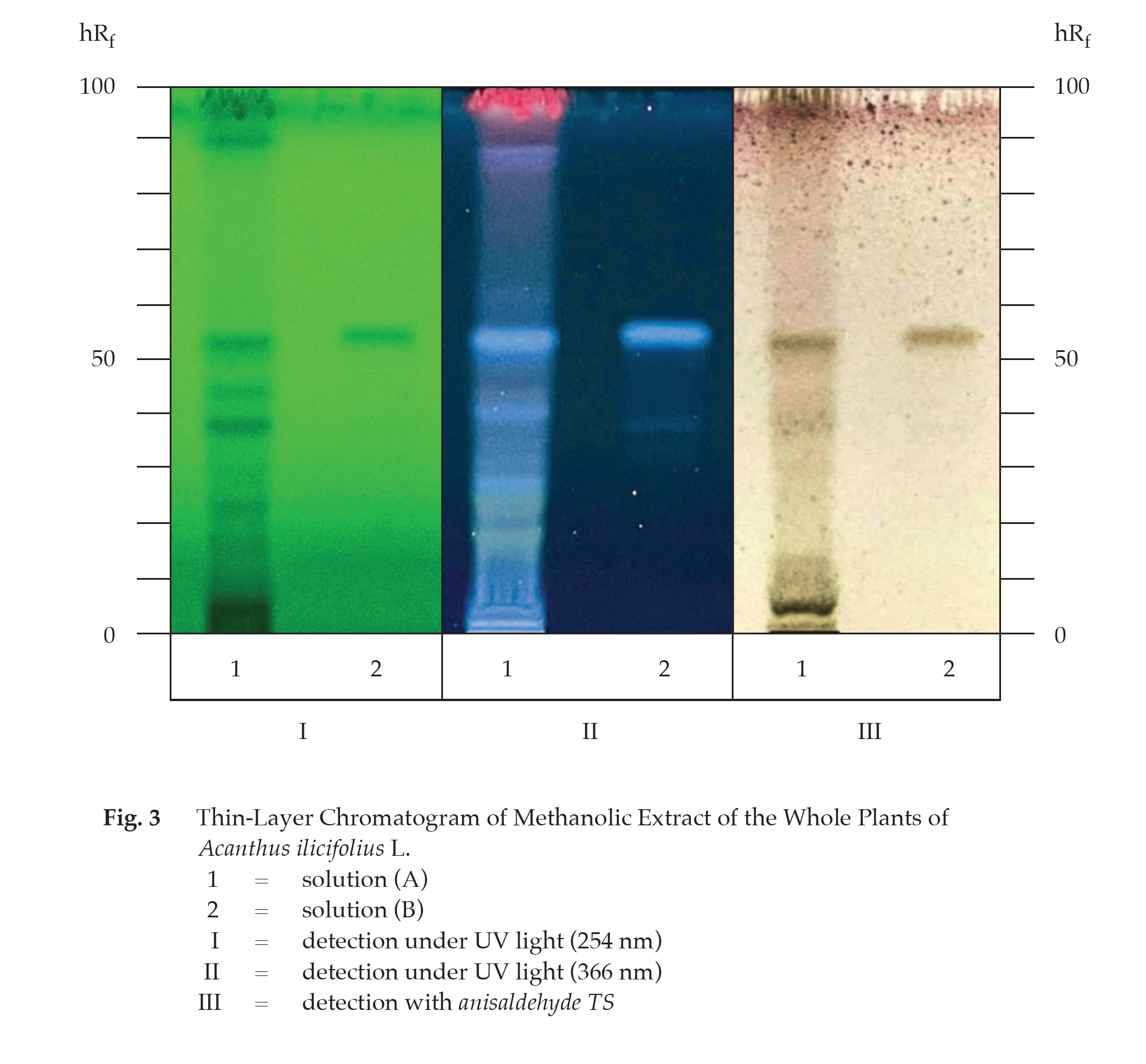ตำรามาตรฐานยาสมุนไพรไทย
Thai Herbal Pharmacopoeia
สำนักยาและวัตถุเสพติด กรมวิทยาศาสตร์การแพทย์ กระทรวงสาธารณสุข
Bureau of Drug and Narcotic, Department of Medical Sciences, Ministry of Public Health(Tinospora crispa (L.) Hook.f. & Thomson)
(Nelumbo nucifera Gaertn.)
(Centella asiatica (L.) Urb.)
(Centella Dry Extract)
(Centella Cream)
(Mesua ferrea L.)
(Piper sarmentosum Roxb.)
(Piper sarmentosum Roxb.)
(Pterocarpus santalinus L. f.)
(Santalum album L.)
(Senna tora (L.) Roxb.)
(Senna alata (L.) Roxb.)
(Senna Alata Tea)
(Piper retrofractum Vahl)
(Myristica fragrans Houtt)
(Andrographis paniculata (Burm. f.) Nees)
(Andrographis Capsules)
(Allium ascalonicum L.)
(Ocimum tenuiflorum L.)
(Curcuma longa L.)
(Turmeric Capsules)
(Turmeric Dry Extract)
(Turmeric Dry Extract Capsules)
(Arcangelisia flava (L.) Merr.)
(Curcuma sp.)
Harrisonia perforata (Blanco) Merr.
(Aristolochia pierrei Lecomte)
(Zingiber officinale Roscoe)
(Ginger Capsules)
(Ginger Tea)
(Cassia fistula L.)
(Nardostachys jatamansi (D. Don) DC.)
(Angelica sinensis (Oliv.) Diels)
Artemisia annua L.
(Ligusticum sinense Oliv. cv. Chuanxiong)
(Neopicrorhiza scrophulariiflora Pennell)
(Atractylodes lancea (Thunb.) DC.)
(Aucklandia lappa Decne)
(Terminalia chebula Retz.)
(Angelica dahurica (Hoffm.) Benth. & Hook. f. ex Franch. & Sav. var. dahurica)
(Kaempferia parviflora Wall. ex Baker)
(Hibiscus sabdariffa L.)
(Roselle Tea)
(Allium sativum L.)
(Zingiber zerumbet (L.) Sm.)
(Wurfbainia testacea (Ridl.) Škorničk.& A. D. Poulsen)
(Cannabis sativa L.)
(Myristica fragrans Houtt)
(Dracaena cochinchinensis (Lour.) S. C. Chen)
(Ficus racemosa L.)
(Hyptis suaveolens (L.) Poit.)
Clerodendrum indicum (L.) Kuntze
(Phyllanthus emblica L.)
(Citrus hystrix DC.)
(Citrus hystrix DC.)
(Areca catechu L.)
(Momordica charantia L.)
Moringa oleifera Lam.
(Aegle marmelos (L.) Corrêa)
(Solanum trilobatum L.)
(Morus alba L.)
Gynostemma pentaphyllum(Thunb.)
Makino
(Clinacanthus nutans (Burm. f.) Lindau)
(Cissus quadrangularis L.)
(Mimusops elengi L.)
(Zingiber montanum (J. König) Link. ex A. Dietr.)
(Piper betle L.)
(Capsicum annuum L.)
(Capsicum Oleoresin)
(Capsicum Gel)
(Piper nigrum L.)
(Piper nigrum L.)
(Eurycoma longifolia Jack)
(Thunbergia laurifolia Lindl.)
(Piper wallichii (Miq.) Hand.-Mazz.)
Senna garrettiana (Craib) H. S. Irwin & Barneby
(Terminalia bellirica (Gaertn.) Roxb.)
(Terminalia chebula Retz.)
(Caesalpinia bonduc (L.) H. Roxb.)
(Tarlmounia elliptica (DC.) H. Rob., S. C. Keeley, Skvaria & R. Chan)
(Hog Creeper Vine Dry Extract Capsiles)
(Hog Creeper Vine Dry Extract)
(Brachypterum scandens (Roxb.) Miq.)
(Lepidium sativum L.)
(Nigella sativa L.)
(Cuminum cyminum L.)
(Foeniculum vulgare Mill.)
(Plantago ovata Forssk.)
(Pimpinella anisum L.)
(Carum carvi L.)
(Anethum graveolens L.)
(Trachyspermum ammi (L.) Sprague)
Albizia procera (Roxb.) Benth.
(Acorus calamus L.)
(Tiliacora triandra (Colebr.) Diels)
Cyanthillium cinereum (L.) H. Rob.
(Orthosiphon aristatus (Blume) Miq.)
Murdannia loriformis (Hassk.) R. S. Rao & Kammathy
(Capparis micracantha DC.)
(Chrysopogon zizanioides (L.) Roberty)
(Cyperus rotundus L.)
(Cannabis sativa L.)
(Syzygium aromaticum (L.) Merr. & L. M. Perry)
(Boesenbergia rotunda (L.) Mansf.)
(Acanthus ebracteatus Vahl)
(Acanthus ilicifolius L.)
(Kaempferia galanga L.)
(Curcuma comosa Roxb.)
Betula alnoides Buch.-Ham. ex D. Don
Cannabis sativa L.
Carthamus tinctorius L
Mitragyna speciosa (Korth.) Havil
Mallotus repandus (Rottler) Müll. Arg
Azadirachta indica A. Juss. var. siamensis Valeton
Azadirachta indica A. Juss. var. siamensis Valeton
Punica granatum L.
Rhinacanthus nasutus (L.) Kurz
Baliospermum solanifolium (Burm.) Suresh
Curcuma aeruginosa Roxb
Boesenbergia kingii Mood & L. M. Prince
Senegalia rugata (Lam.) Britton & Rose
Acacia concinna (Willd.) DC.
Senegalia rugata (Lam.) Britton & Rose
Acacia concinna (Willd.) DC.
Senna alexandriana Mill. var. alexandriana
Cassia acutifolia Delile, Cassia angustifolia Vahl
Butea superba Roxb. ex Willd.
[Plaso superba (Roxb. ex Willd.) Kuntze, Rudolphia superba (Roxb. ex Willd.) Poir.
Pueraria candollei Graham
ex Benth. var. mirifica (Airy Shaw & Suvat.) Niyomdham
Streblus asper Lour.
Suregada multiflora (A. Juss.) Baill. (Gelonium
multiflorum A. Juss.
Acanthus Ilicifolius Herb is the dried whole plant of Acanthus ilicifolius L. [A. doloarin Blanco, A. neoguineensis Engl., Dilivaria ilicifolia (L.) Juss.] (Family
Acanthaceae), Herbarium Specimen Number: DMSC 5253, Crude Drug Number: DMSc 1203.
Constituents Acanthus Ilicifolius Herb contains phenolic glycosides (e.g., acteoside or verbascoside) and flavone glycosides.
Description of plant (Figs. 1) Shrub, up to 2.5 m tall; stem erect, terete, stout, branched, slightly lenticellate, glabrous and glossy, succulent, green to brownish green; sometimes with stipule-like spines at node, caducous; prop root usually abundant. Leaves simple, oppositedecussate, oblong to oblong-lanceolate, 6 to 14 cm long, 2 to 5 cm wide, apex acute and slightly mucronate, base cuneate, margin 3- to 7-toothed, serrate, subentire or rarely entire,subcoriaceous to coriaceous, upper surface green to dark green, glossy, lower surface pale green, glabrous on both surfaces, secondary veins 5 to 7 on each side of midrib, spreading to spinose teeth margin; petiole 0.3 to 1.5 cm long, thick, glabrous, continued into prominent midrib. Inflorescence spike, terminal or axillary, erect, up to 16.5 cm long; bract broadly ovate to lanceolate, 0.7 to 1 cm long, about 5 mm wide; bracteoles 2, oblong-lanceolate, 3 to
8 mm long, 2 to 5 mm wide; calyx 4-lobed, light green, obovate-oblong, 2 outer ones larger, about 2 cm long, about 1 cm wide, 2 inner ones up to 1.8 cm long, up to 8 mm wide, apex mucronate, margin scarious, ciliolate; corolla usually purplish with yellow band, 3 to 4 cm long, tube about 6 mm long, lip obovate, 2.2 to 3 cm long, thin-leathery, outside soft hairy, apex obtusely 2-lobed, with small lobe in the middle; stamens 4, unequal, attached to corolla
throat, filament about 1.5 cm long, stiff, anther theca linear-oblong, densely hairy; disc annular and penicillate; ovary superior, 2-loculed, each locule with 2 ovules, style about 2.2 cm long, glabrous, stigma bifid. Fruit a capsule, ovoid, 1.6 to 3.4 cm long, green and glossy. Seeds 4, orbicular or reniform, up to 1.5 cm in diameter, light yellow, flattened, rugulose or corrugate.
Description Odour, characteristic; taste, slightly salty-astringent.
Macroscopical (Fig. 1) Whole plant occurs as a mixture of unbroken or broken, crisp, mainly brownish leaves with spinose teeth margin; terete and lenticellate stems with spines at node; elliptic to oblong capsules; some with roots and part of inflorescences.
Microscopical (Figs. 2a, 2b, 2c, 2d, 2e, 2f) Transverse section of the leaf shows upper epidermis, hypodermis, mesophyll, vascular bundle, and lower epidermis. Upper epidermis: a layer of small rectangular cells covered with cuticle, sunken salt glands with 8- to 12-celled head and short stalk. Hypodermis: 2 to 4 layers of large- and thin-walled cells. Mesophyll: palisade cells, 2 to 3 layers and cylindrical; spongy cells, polygonal-shaped and loosely arranged; collenchyma, angular and several layers; parenchyma, thin-walled and round; both collenchyma and parenchyma found in the upper and lower parts of
midrib. Lower epidermis: 1 to 3 layers of small rectangular cells covered with cuticle, sunken salt glands with 8- to 12-celled head and short stalk.

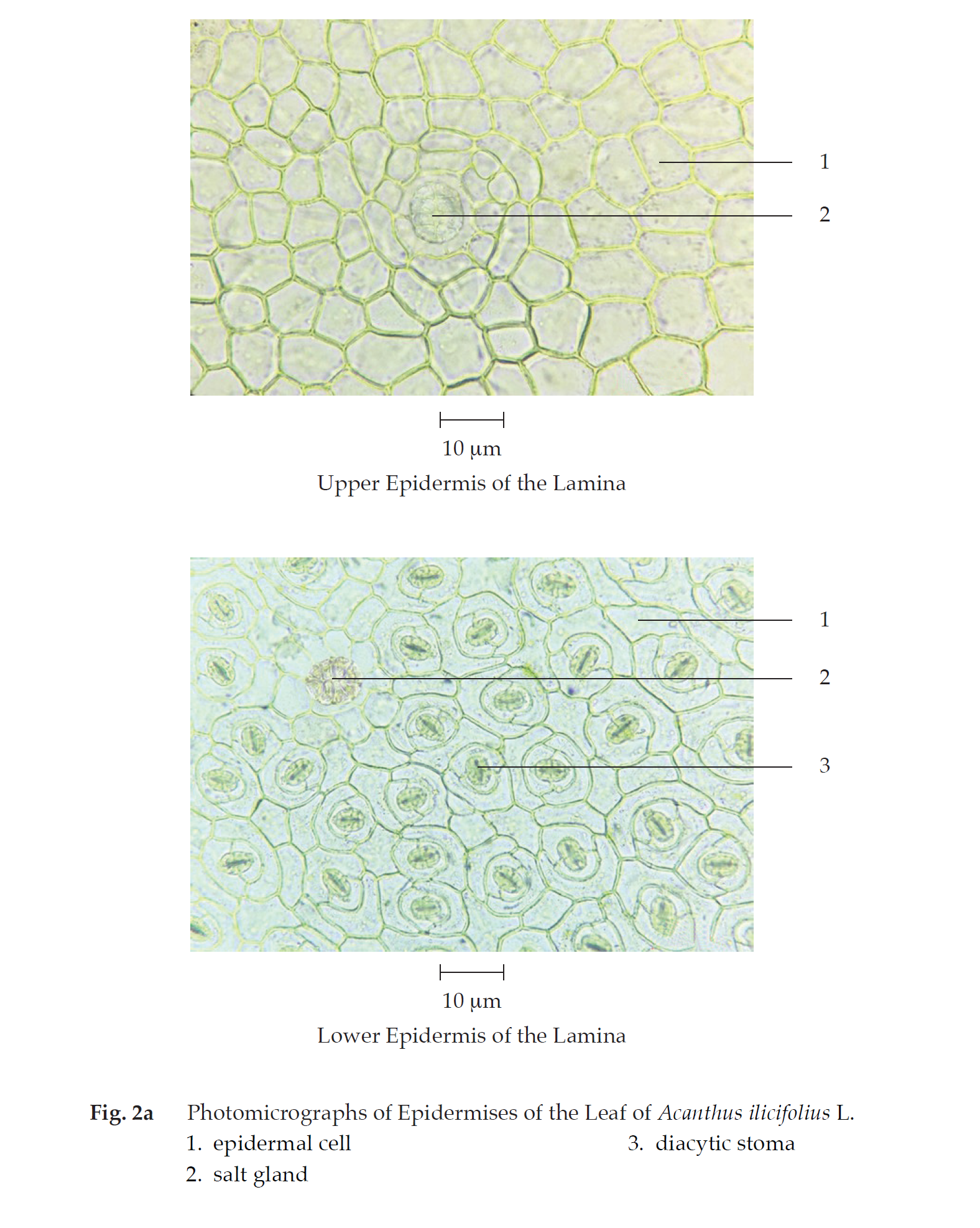

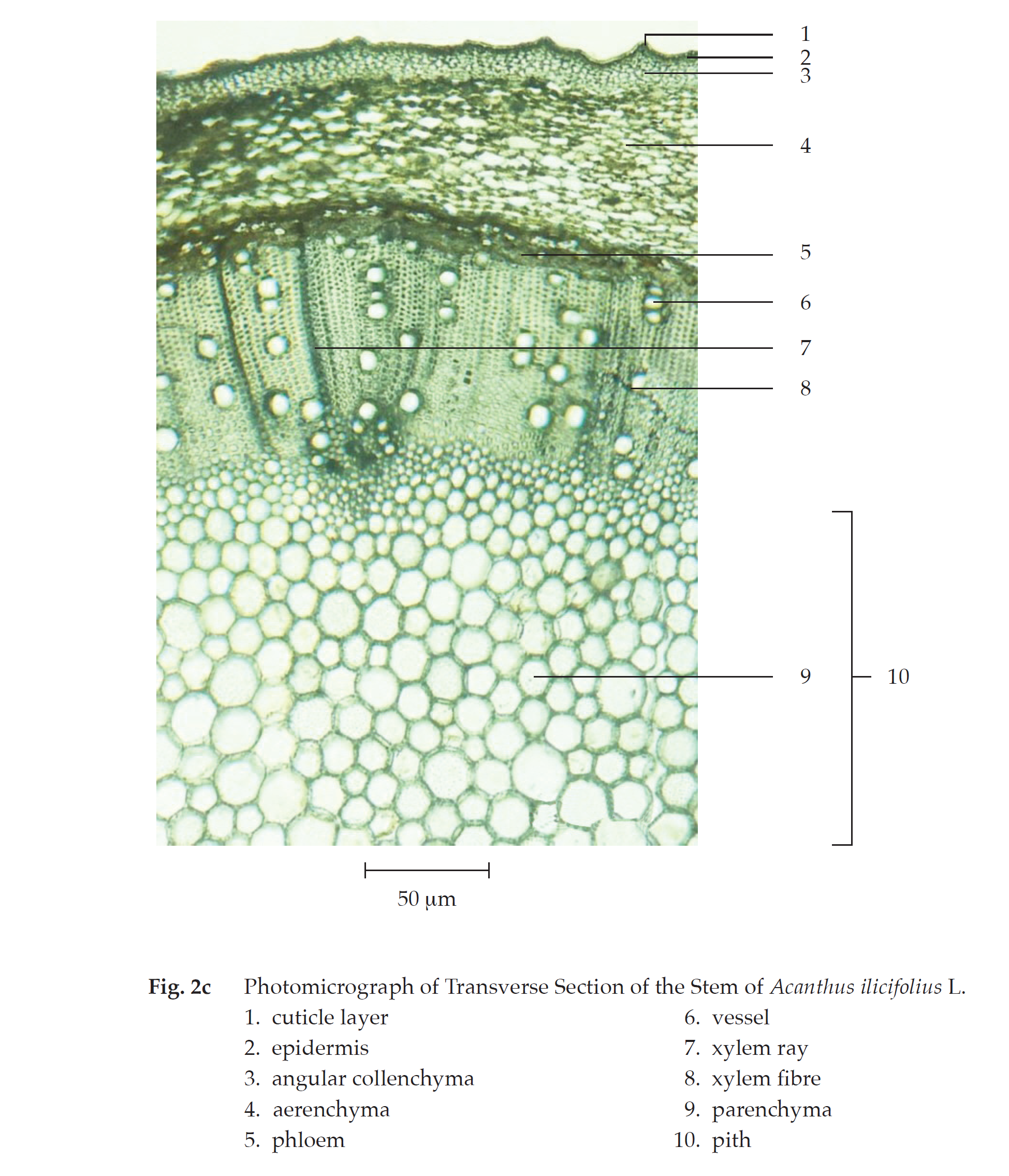
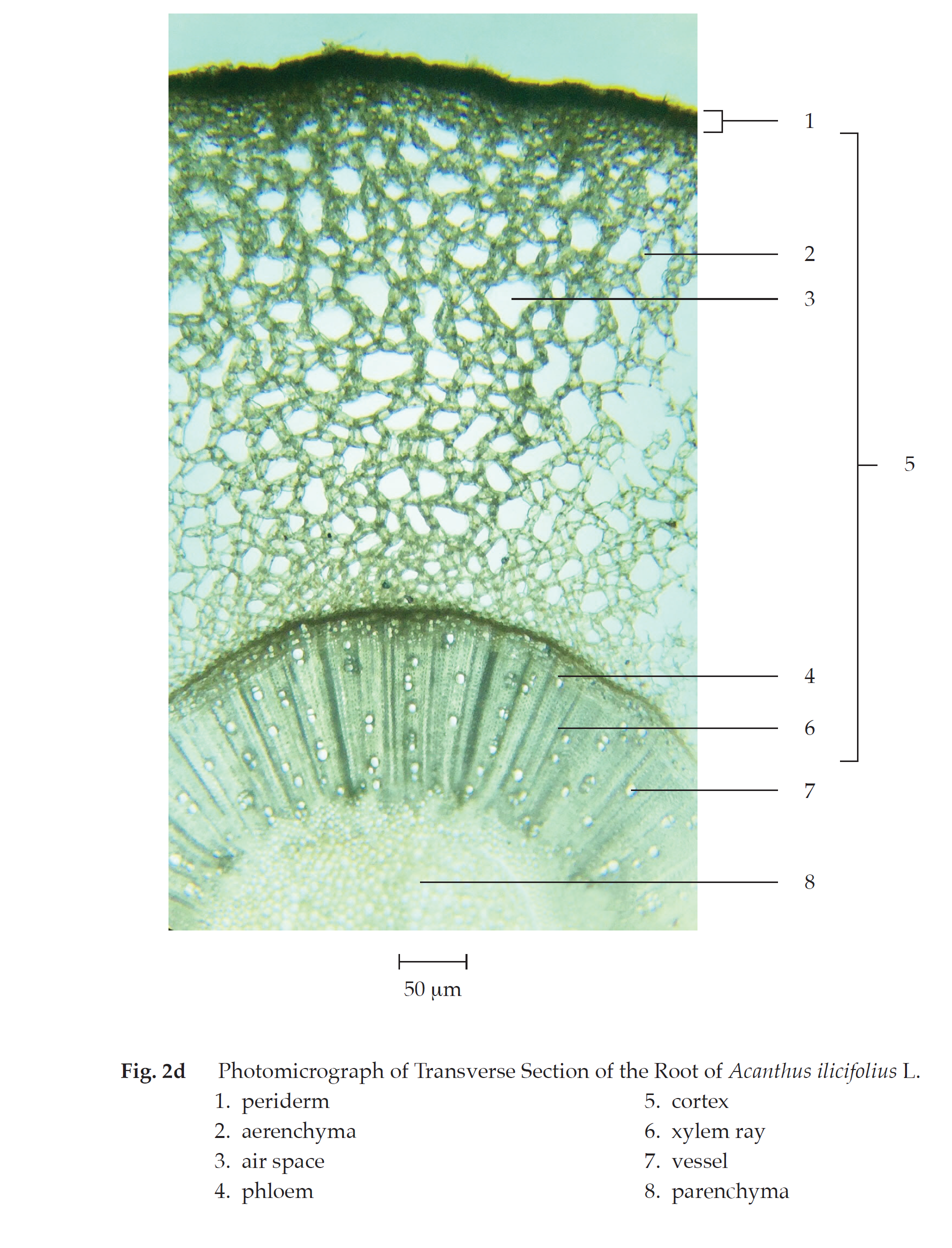
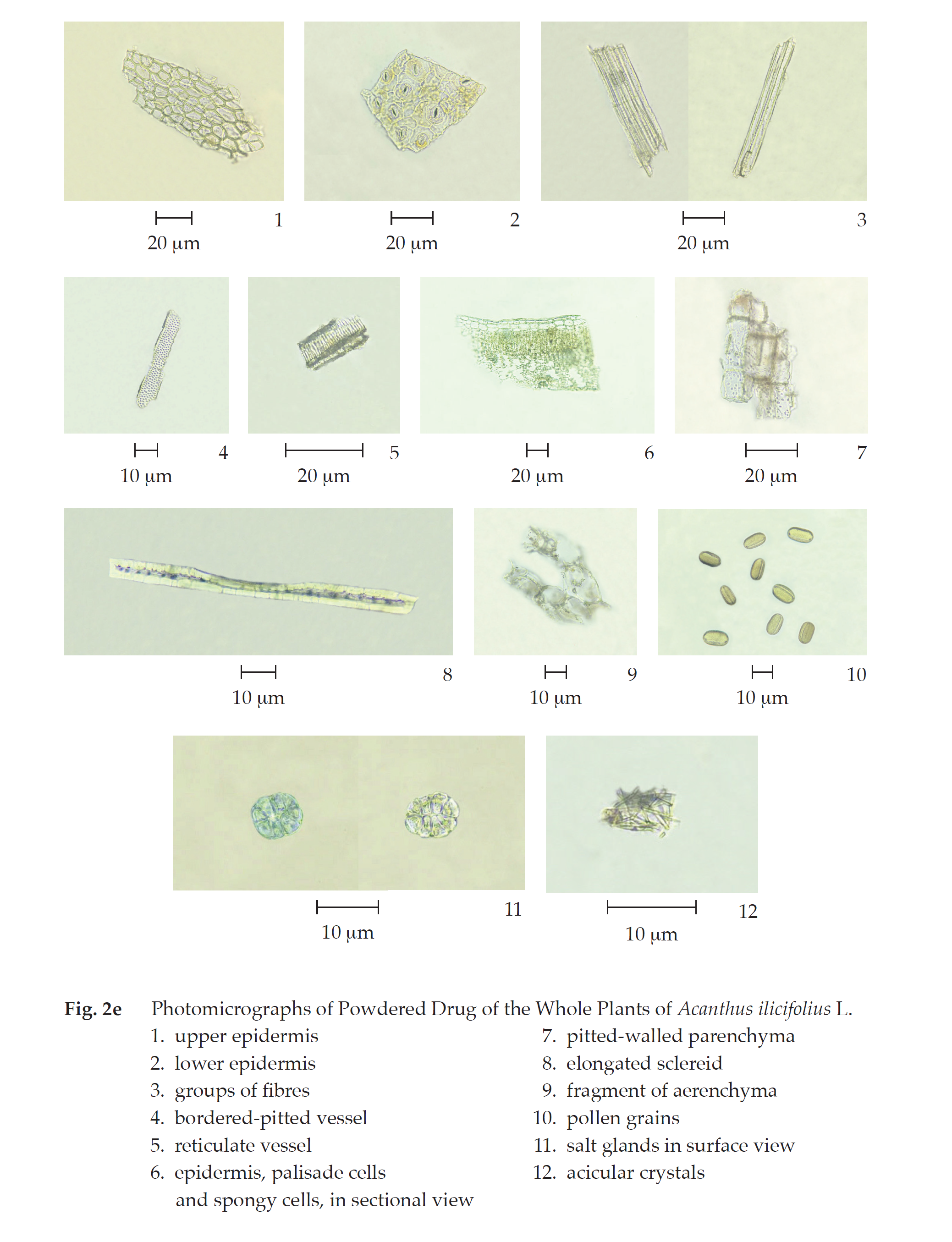
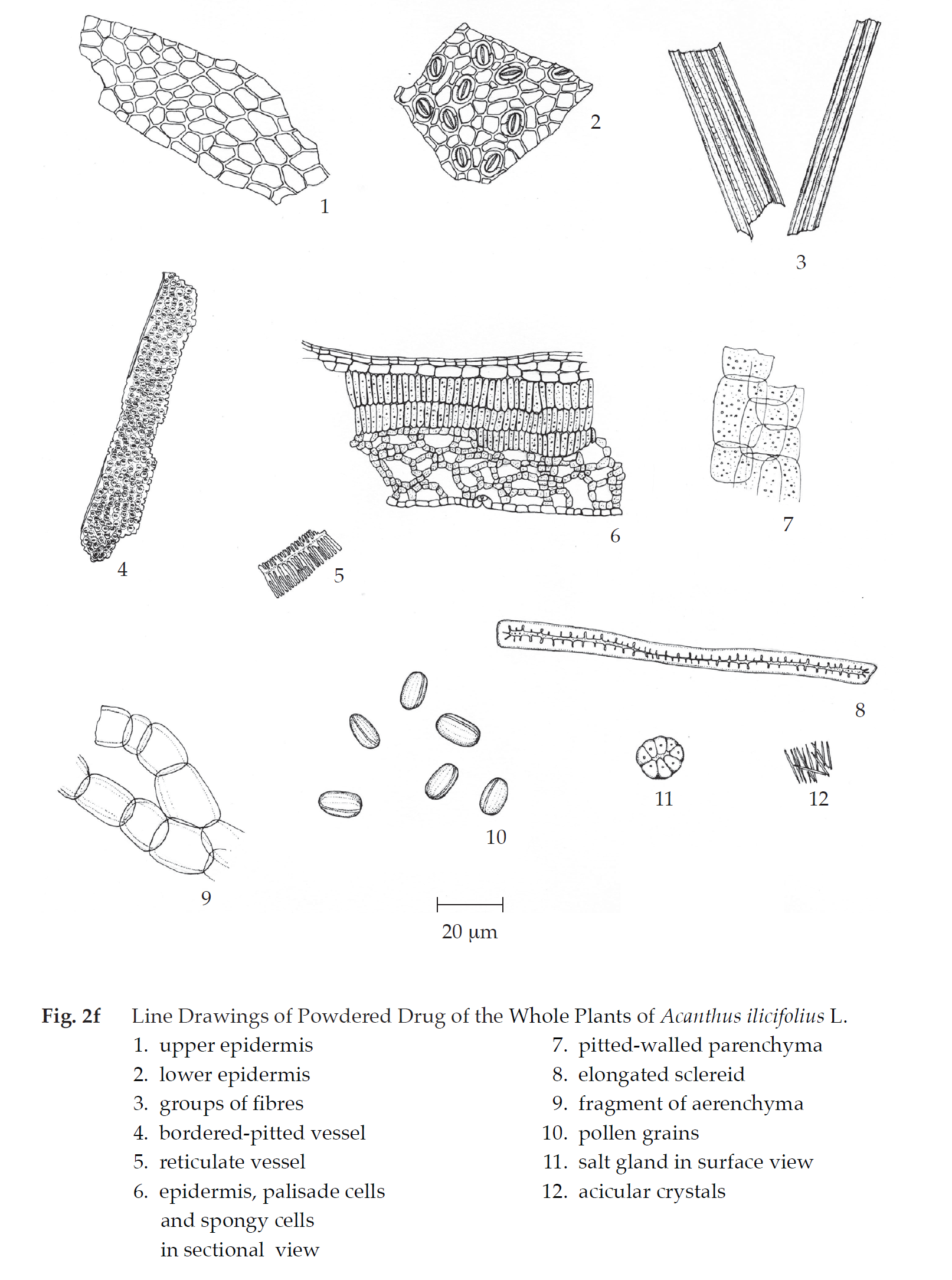
In surface view, upper epidermis of the lamina shows polygonal cells and salt glands with 8- to 12-celled head; lower epidermis, slightly wavy-walled polygonal cells, numerous diacytic stomata and salt glands with 8- to 12-celled head.
Transverse section of the stem shows epidermis, cortex, vascular tissue, and pith. Epidermis: a layer of various-shaped epidermal cells, with thick cuticle. Cortex: several layers of angular collenchyma, sclereid and several layers of thin-walled aerenchyma. Vascular tissue: phloem and xylem. Pith: various sizes of polygonal pitted parenchyma, slightly thick-walled.
Transverse section of the root shows periderm, cortex, vascular tissue, and pith. Periderm: several layers of small rectangular cork cells. Cortex: broad zone of thin-walled aerenchyma. Vascular tissue: phloem and xylem; phloem, thin-walled parenchyma; xylem, vessels, xylem parenchyma, fibres, and xylem rays. Pith: pitted parenchyma.
Acanthi Ilicifolii Herba in powder possesses the diagnostic microscopical characters of the unground drug. Fibres, bordered-pitted vessels, and epidermal cells of lamina are frequently observed. Pollen grains and acicular crystals may also be seen. However, elongated sclereids from stem, salt glands with 8- to 12-celled head and diacytic stomata are characteristic.
Additional information It is commonly used with other herbal drugs in Thai traditional herbal preparations.
Packaging and storage Acanthus Ilicifolius Herb shall be kept in well-closed containers, protected from light, and stored in a dry place.
Identification
A. Heat 5 g of the sample, in powder, with 15 mL of water in a water-bath for 5 minutes and filter. To 1 mL of the filtrate, add a few drops of iron(III) chloride TS and mix well: a dark blue colour is produced.
B. Carry out the test as described in the “Thin-Layer Chromatography” (Appendix 3.1), using silica gel GF254 as the coating substance and a mixture of 70 volumes of ethyl acetate, 10 volumes of methanol, 10 volumes of water, and 10 volumes of formic acid as the mobile phase and allowing the solvent front to ascend 8 cm above the line of application. Apply separately to the plate as bands of 10 mm, 6 µL each of the following two solutions. Prepare solution (A) by sonicating 2 g of the sample, in No. 250 powder, with 20 mL of methanol for 10 minutes and filtering. Evaporate the filtrate under reduced pressure to dryness and dissolve the residue in 5 mL of methanol. For solution (B), dissolve 1 mg of verbascoside in 5 mL of methanol. After removal of the plate, allow it to dry in air and examine the plate under ultraviolet light (254 nm), marking the quenching bands. The chromatogram obtained from solution (A) shows a quenching band (hRf value 55 to 59) corresponding to the verbascoside band from solution (B); several other quenching bands are also observed. Subsequently examine the plate under ultraviolet light (366 nm) through the cut-off filter, the band corresponding to verbascoside shows a blue fluorescence. Spray the plate with anisaldehyde TS and heat at 105º for 5 minutes; the band due to verbascoside is brown. The other two brown bands are observed (Fig. 3).
Loss on drying Not more than 11.0 percent w/w after drying at 105º to constant weight (Appendix 4.15).
Foreign matter Not more than 2.0 percent w/w (Appendix 7.2).
Acid-insoluble ash Not more than 1.0 percent w/w (Appendix 7.6).
Total ash Not more than 13.0 percent w/w (Appendix 7.7).
Ethanol-soluble extractive Not less than 9.0 per cent w/w (Appendix 7.12).
Water-soluble extractive Not less than 11.0 per cent w/w (Appendix 7.12).
